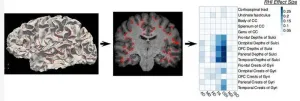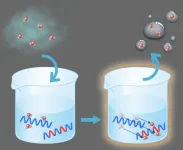(Press-News.org) Factors beyond carbohydrates have a substantial influence on blood glucose levels meaning current automated insulin delivery systems miss vital information required for glucose regulation, a new study has found.
A team of researchers from the University of Bristol analysing automated insulin delivery data from people with Type 1 Diabetes (T1D) discovered that unexpected patterns in insulin needs are just as common as well-established ones.
The study, published today in JMIRx Med aimed to identify patterns in changes of insulin needs and to analyse how frequently these occur in people with T1D who use the OpenAPS, a state-of-the-art, automated insulin delivery system (AID).
Lead author Isabella Degen from Bristol’s Faculty of Science and Engineering explained: “The results support our hypothesis that factors beyond carbohydrates play a substantial role in euglycemia – the state when blood glucose levels are within the standard range.
“However, without measurable information about these factors, AID systems are left to adjust insulin cautiously with the effect of blood glucose levels becoming too low or high.”
Type 1 Diabetes is a chronic condition in which the body produces too little insulin, a hormone needed to regulate blood glucose.
The principal treatment for T1D is insulin that is injected or pumped. The amount and timing of insulin must be skilfully matched to carbohydrate intake to avoid increased blood glucose levels. Beyond carbohydrates, various other factors such as exercise, hormones, and stress impact insulin needs. However, how often these factors cause significant unexpected effects on blood glucose levels has been little explored, meaning that despite all advances, insulin dosing remains a complex task that can go wrong and result in blood glucose levels outside the range that protects people with T1D from adverse health effects.
The findings highlight the complexity of glucose regulation in T1D and demonstrate the heterogeneity in insulin needs among people with T1D, underlining the need for personalised treatment approaches.
For factors beyond carbohydrates to become more systematically included in clinical practice, scientists need to find a way to measure and quantify their impact and utilise this information in insulin-dosing. This could also aid more accurate blood glucose forecasting, which the study showed is not consistently possible from information about insulin and carbohydrates alone.
Isabella added: “Our study highlights that managing Type 1 Diabetes is far more complex than counting carbs.
“The richness of insights that can be gained from studying automated insulin delivery data is worth the effort it takes to work with this type of real-life data.
“What surprised us most was the sheer variety of patterns we observed, even within our relatively small and homogenous group of participants.
“It's clear that when it comes to diabetes management, one size doesn't fit all.
“We hope our results inspire further research into lesser-explored factors that influence insulin needs to improve insulin dosing.”
The team are now working on advancing time series pattern-finding methods that can handle the diverse and complex nature of real-life medical data, including irregular sampling and missing data. Their current focus is on developing innovative segmentation and clustering techniques for multivariate time series data tailored to uncover more granular patterns and handle the challenges posed by AID data.
To support this future research, the team seeks long-term, open-access AID datasets that include a wide range of sensor measurements of possible factors and a diverse cohort of people with T1D. Additionally, they aim to collaborate with time series and machine learning experts to address technical challenges such as handling irregularly sampled data with varying intervals between variates, and uncovering causalities behind observed patterns to ultimately driving innovations in personalised care.
Paper
‘Beyond Expected Patterns in Insulin Needs of People With Type 1 Diabetes: Temporal Analysis of Automated Insulin Delivery Data’ by Isabella Degen, Kate Robson Brown, Henry W J Reeve, Zahraa Abdallah in JMIRx Med.
Contact: lauram.thomas@bristol.ac.uk
END
No ‘one size fits all’ treatment for Type 1 Diabetes, study finds
2024-11-27
ELSE PRESS RELEASES FROM THIS DATE:
New insights into low-temperature densification of ceria-based barrier layers for solid oxide cells
2024-11-27
Solid oxide cells (SOCs), including solid oxide fuel cells (SOFCs) and solid oxide electrolysis cells (SOECs), are among the most promising energy conversion technologies due to their high efficiency and fuel flexibility. However, the high-temperature sintering required for their manufacture often leads to undesirable reactions at the electrolyte and electrode interface, degrading cell performance. A thin, dense ceria-based barrier layer, typically composed of gadolinium-doped ceria (GDC), is widely used to prevent these reactions. Achieving sufficient densification ...
AI Safety Institute launched as Korea’s AI Research Hub
2024-11-27
The Ministry of Science and ICT (MSIT), headed by Minister Yoo Sang-im, held the launch ceremony for the "AI Safety Institute" (AISI) on Wednesday, November 27, at the Pangyo Global R&D Center.
At the "AI Seoul Summit"last May, leaders from 10 countries recognized safety as a key component of responsible AI innovation and emphasized the importance of establishing AI safety institutes and fostering global collaboration for safe AI. President Yoon Suk Yeol also expressed his commitment, stating, "We will work towards establishing an AI safety institute in Korea and actively participate ...
Air pollution linked to longer duration of long-COVID symptoms
2024-11-27
Exposure to air pollutants (PM2.5 and PM10) is associated with an increased risk of persistent long-COVID symptoms, partly due to its impact on the severity of the acute infection. This is the main conclusion of a study led by the Barcelona Institute for Global Health (ISGlobal), a centre supported by “la Caixa” Foundation, in collaboration with the Germans Trias i Pujol Research Institute (IGTP), and published in Environmental Health Perspectives.
Long-COVID is a heterogeneous condition in which symptoms like fatigue, breathlessness, and cognitive issues persist for months after ...
Soccer heading damages brain regions affected in CTE
2024-11-27
CHICAGO – Soccer heading may cause more damage to the brain than previously thought, according to a study being presented next week at the annual meeting of the Radiological Society of North America (RSNA).
Heading is a widely used technique in soccer where the players control the direction of the ball by hitting it with their head. In recent years, research has been done that suggests a link between repeated head impacts and neurodegenerative diseases, such as chronic traumatic encephalopathy (CTE).
“The potential effects of repeated head impacts in sport are ...
Autism and neural dynamic range: insights into slower, more detailed processing
2024-11-27
A new study has linked distinct neural and behavioral characteristics in autism spectrum disorder to a simple computational principle. Centered on the “dynamic range” of neurons, which reflects how gradually or sharply they respond to input, the study suggests that individuals with autism spectrum disorder have an increased dynamic range in their neuronal response, resulting in a more detailed but slower response to changes. This research defies previous descriptions of ASD as a “broken cog in the machine” and provides a deeper, richer account of the computational basis of ASD.
[Hebrew University of Jerusalem]– Researchers Dr. Yuval Hart and Oded ...
AI can predict study results better than human experts
2024-11-27
Large language models, a type of AI that analyses text, can predict the results of proposed neuroscience studies more accurately than human experts, finds a new study led by UCL (University College London) researchers.
The findings, published in Nature Human Behaviour, demonstrate that large language models (LLMs) trained on vast datasets of text can distil patterns from scientific literature, enabling them to forecast scientific outcomes with superhuman accuracy.
The researchers say this highlights ...
Brain stimulation effectiveness tied to learning ability, not age
2024-11-27
As we age, our cognitive and motor functions deteriorate, which in turn affects our independence and overall quality of life. Research efforts to ameliorate or even completely abolish this have given rise to technologies that show a lot of promise.
Among these is non-invasive brain stimulation: a term encompassing a set of techniques that can affect brain functions externally and noninvasively, without the need for surgery or implants. One such promising technique, in particular, is anodal transcranial direct current stimulation (atDCS), which uses ...
Making a difference: Efficient water harvesting from air possible
2024-11-27
Harvesting water from the air and decreasing humidity are crucial to realizing a more comfortable life for humanity. Water-adsorption polymers have been playing a key part in atmospheric water harvesting and desiccant air conditioning, but desorption so that the polymers can be efficiently reused has been an issue. Now, Osaka Metropolitan University researchers have found a way to make desorption of these polymers more efficient.
Usually, heat of around 100°C is required to desorb these polymers, but Graduate School of Engineering student Daisuke Ikegawa, Assistant Professor Arisa Fukatsu, ...
World’s most common heart valve disease linked to insulin resistance in large national study
2024-11-27
A large new population study of men over 45 indicates insulin resistance may be an important risk factor for the development of the world’s most common heart valve disease – aortic stenosis (AS).
Published today in the peer-reviewed journal Annals of Medicine, the findings are believed to be the first to highlight this previously unrecognised risk factor for the disease.
It is hoped that by demonstrating this link between AS and insulin resistance – when cells fail to respond effectively to insulin and the body makes more than necessary to maintain normal glucose ...
Study unravels another piece of the puzzle in how cancer cells may be targeted by the immune system
2024-11-27
Effective immunity hinges on the ability to sense infection and cellular transformation. In humans, there is a specialised molecule on the surface of cells termed MR1. MR1 allows sensing of certain small molecule metabolites derived from cellular and microbial sources; however, the breadth of metabolite sensing is unclear.
Published in PNAS, researchers at the Monash University Biomedicine Discovery Institute have identified a form of Vitamin B6 bound to MR1 as a means of engaging tumour-reactive immune cells. The work involved an international collaborative team co-led by researchers from the University of Melbourne.
According ...

